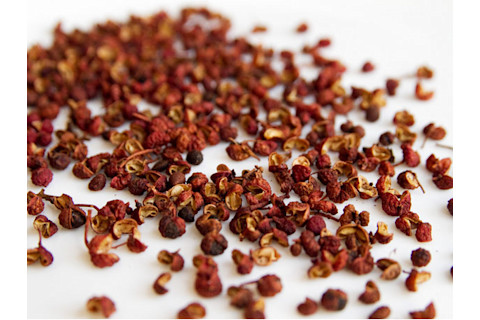One of the most aggressive flavors we can experience is spiciness. Imagine a bright red chili pepper whose color gives us fair warning of its propensity to ignite a fire. In fact, a common physiological response to eating spicy food is analogous to the way our body responds to an elevation in internal body temperature. You can feel the burn. The consumption of spicy ingredients triggers our exocrine (sweat) glands to secrete fluid at the skin’s surface to promote cooling through the evaporation of our perspiration. So how is it that spicy food can make us sweat?

Red Chili Peppers [Photo Credit: The Paleo Diet]

Chemical Structure of Capsaicin [Photo Credit: Dartmouth] The answer lies in our head. Our body’s reaction to spiciness is a result of input delivered from receptors in our mouth to our central nervous system. A compound found in many spicy ingredients such as chili peppers is called capsaicin. This molecule activates sensory neurons in our mouth called thermal nociceptors [1,2]. The activation of these thermal pain receptors in turn stimulates our sympathetic nervous system [3], which is associated with our body’s “flight-or-flight” responses. Therefore, the characteristic increase in heart rate and sweat production due to the consumption of capsaicin-rich ingredients is due in part to the capsaicin’s role in adrenaline secretion [4]. If you decide to brave the spice, here’s some advice: When it comes to relieving the pain of the capsaicin burn, your best bet is to have a glass of cold milk or better yet, a bowl of ice cream. The compound, casein, is a hydrophobic substance found in milk that operates to “absorb” the lipid-rich capsaicin molecules making it easier to cleanse your mouth of the spicy chemical [5]. However, capsaicin isn’t the only fiery compound that can elicit unique physiological responses. On the other end of the spectrum is a compound known as hydroxyl-alpha sanshool, commonly found in Z. Bungaenum peppercorns. This variety of peppercorn is commonly grown in the Sichuan province of China, and is referred to as the Sichuan peppercorn. The characteristic “flavor sensation” one might experience when eating Sichuan cuisine is a mind-numbing spiciness. Here’s how that happens.

Sichuan Peppercorns [Photo Credit: Serious Eats]

Chemical Structure of Hydroxy-Alpha Sanshool [Photo Credit: Hong Kong University] Hydro-alpha sanshool activates somatosensory neurons that are responsible for detecting innocuous stimuli such as a gentle touch. This is opposite of the nociceptors that detect capsaicin which primarily detect noxious or painful stimuli. The stimulation of somatosensory neurons by hydro-alpha sanshool produces a similar effect to local anesthetics used to moderate pain in surgery. The compound found in Sichuan peppercorns trigger somatosensory neurons to prevent the influx and efflux of electrolytes, Na^+ and K^+, through ion channels [6,7]. The resulting effect of hydro-alpha sanshool is to cease the propagation of neuronal action potential through the nervous system’s pain pathways. So, when you enjoy a delicious dish of Liang Fen (Cold Mung Bean Noodles with Sichuan Peppercorn/Chili Vinegar), or Suan Cai Yu (Poached Fish in Green Sichuan Peppercorn Sauce) you can experience thrilling mouth numbness. Your first instinct after eating these dishes will be to grab the closest glass of water available to you. Interestingly, a sip of flat water after eating these dishes will produce a surprising fizziness like you might experience while drinking sparkling water.

Liang Fen: Cold Mung Bean Noodles with Sichuan Peppercorn/Chili Vinegar [Photo Credit: Serious Eats]

Liang Fen: Cold Mung Bean Noodles with Sichuan Peppercorn/Chili Vinegar [Photo Credit: Serious Eats] References cited
Caterina, M., Schumacher, M., Tominaga, M., Rosen, T., Levine, J., Julius, D. “The capsaicin receptor: a heat-activated ion channel in the pain pathway”. Nature. 389 (1997): 816-824.
Liu, M., Max, M., Parada, S., Rowan, J., Bennett, G. “The Sympathetic Nervous System Contributes to Capsaicin-Evoked Mechanical Allodynia But Not Pinprick Hyperalgesia in Humans” The Journal of Neuroscience. 16.22 (1996): 7331-7335.
Ohnuki, K., Moritani, T., Ishihara, K., Fushiki, T. “Capsaicin Increases Modulation of Sympathetic Nerve Activity in Rats: Measurement Using Power Spectral Analysis of Heart Rate Fluctuations”. Bioscience, Biotechnology, and Biochemistry. 65.3 (2001): 638-643.
Watanabe, T., Sakurada, N., Kobata, K. “Capsaicin-, Resiniferatoxin-, and Olvanil-Induced Adrenaline Secretions in Rats Via the Vanilloid Receptor” Bioscience, Biotechnology, and Biochemistry. 65.11 (2001): 2443-2447.
Fire and Spice. General Chemistry Online!.
Tsunozaki, M., Lennertz, RC., Vilceanu, D., Katta, S., Stucky, CL., Bautista, DM. “A ‘Toothache Tree’ Alkylamide Inhibits AD Mechanonociceptors to Alleviate Mechanical Pain” Journal of Physiology. 591 (2013) 3325-3340.
Bautista, DM., Sigal, YM., Milstein, AD., Garrison, JL., Zorn, JA., Tsuruda, PR., Nicoll, RA., Julius, D. “Pungent Agents from Szechuan Peppers Excite Sensory Neurons by Inhibiting Two-Pore Potassium Channels” Nature Neuroscience. 11.7 (2011): 772-779.
Anthony Martin received his Ph.D. in Genetic, Cellular and Molecular Biology at USC and is self-publishing a cookbook of his favorite Filipino dishes. Read more by Anthony Martin

About the author:













